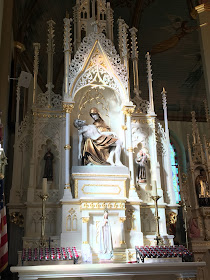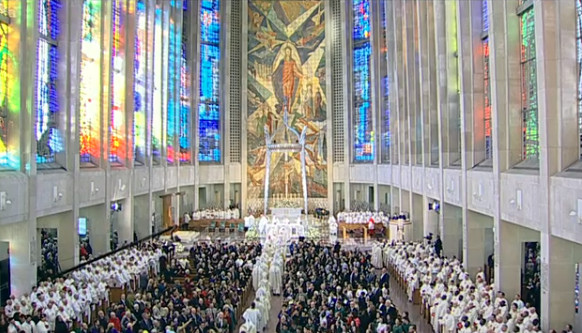 |
I read them the Numbers....
source: Cornell Catholic Community's Facebook page |
"Oh, Rad Trad! How are you today, Rad Trad?"
A doey, dopey eyed student asked me as I walked into the chapel for a weekday Mass during my student days. This shorts-wearing man was the perfect JP2 Catholic: young, pro-life, liturgically liberal, Ultramontane in all matters, and he read the new Catechism every night before going to sleep. A kind, simple soul of exceptional devotion whose capacity for creative thought had been circumscribed by too many sports related concussions.
"Would you like to prepare a reading today, Rad Trad?"
"If it will make you feel better, alright," I acquiesced.
I reviewed the material in the lectionary for any Hebraic words or turns of phrase that might rattle my dyslexic eyes and found none. After the
Collect Opening Prayer I assumed my place at the ambo and began with the immemorial words, "A reading from the book of Numbers."
A rare thought, gentle and fleeting, like a dandelion petal, that comes to a man only a few times in his life if he is careful enough to nurture it, came to me: "What the hell am I doing?"
The year was 2011, the apogee of Benedict XVI's pontificate, which in retrospect shared much with Pius XII's in looking much better on the outside than on the inside. We were reviving the "never abrogated" 1962 Missal and calling it the "extraordinary form," sticking the Big Six on the altar of Pauline Masses, and telling ourselves that the average parish Mass is not how Paul VI
really wanted it. Liturgical conferences with Scott Alcuin Reid abounded and "mutual enrichment" was the defining phrase of obedient clergy. The new Mass could learn much from the old form's prolix reverence, mystery, orientation, and sense of the sacred. But, so the other side of the enrichment went, the old Mass could be inferior to the new in any number of ways, not least of which was the expanded lectionary. As I read figures for building dimensions and storage capacity to the JP2 generation and some paid staff, I concluded the benefits of the expanded lectionary were doubtful.
Peter Kwasniewski
rightly points out that the expanded lectionary has allowed grave passages of Holy Writ to be omitted or relegated to obscure times of the year so that they do not appear whenever the church is full; most infamously, St. Paul's admonition against unworthy participation in the Lord's Supper never made it into the lectionary of Paul VI. Dr. K likens the new lectionary to a Cliff Notes version of Shakespeare that includes a large quantity of material, but which censors any passages unsavory to modern ears and modern morals. Quantity over quality.
Another, less often considered problem of the new lectionary is that it drowns any sense of rhythm and thematic continuity with its "Scripture for Scripture's sake" methodology. Keeping with the motif of the Bard, Shakespeare's sonnets are best understood when read aloud so that the pattern of speech and repeated images may mature line to line. The old lectionary used a few sonnets in whole; the new lectionary reads them all in sequence, but never more than five or six of the fourteen lines at a time.
Criticism of the older lectionary and support for the pedantic three year cycle of Paul VI rest on the ahistorical assumption that the Eucharistic sacrifice is the appropriate place for
ad libitum readings of Scripture. The original setting for Scriptural lessons, East and West, was the Mattins of the all-night vigil, from which only the Roman rite retained consistent readings; the Byzantine rite does maintain extensive pericopes during Vespers of Great Lent and major feasts. As with the Mass, Romans initially observed the vigil only for Sundays and great feasts, which is reflected in the coherence of the passages for the most ancient feasts (Pascha, Pentecost, Theophany, Christmas, Peter & Paul, Andrew, John the Baptist, and the like). Rome eventually followed the Constantinopolitan custom of observing the vigil every night and began to read Scriptures sequentially through different books each month. Mass, with its instructive lessons geared toward the solemnization of a particular mystery celebrated on a given day, remained unique to feasts, Sundays, and days of penance; there was no daily Mass in St. Peter's Basilica, but there was a daily Office. Local churches had particular Masses for saints more often than the Roman Church, which contented itself with Common Mass formularies for martyrs, bishops, and virgins; by the time of St. Pius V's Missal, half the days of the year were still of either Simplex of Ferial rank, so the repetition of the numerous Commons was hardly as dull and numbing as it was by the time of Papa Sarto's reforms and the rite of
Iste Confessor. The considerable number of Ferial and Simplex days also permitted votive Masses of Saints and of Requiem when appropriate, providing a variety of Mass options with unified Scriptural lessons concerning the saint or mystery observed. All of this would gradually change, and perspective with it, in the years after Trent.
The Tridentine Council required the Breviary of every ordained cleric in the Latin Church. Pius V's breviary lessons are similar to those in medieval books, but subsequent popes shortened many readings to lessen priests' burden; contrary to the curt Roman Office, Cluny covered such extensive passages of Holy Writ that a monk with a bat would roam the choir during Mattins to tap anyone who had fallen asleep during the daily reading of many chapters. Mass replaced the Office as the daily observance of parishes and cathedrals, especially Mass in the spoken form, wherein words are less audible to the faithful, faithful who were often speakers of Romance tongues descended from Latin. Similarly, the number of saints multiplied and their feasts were almost always assigned a Duplex rank with a Common Mass, compelling priests to recite the same Masses week after week. By the time of Vatican I one could hardly go a week without a Mass or two that began
Os iusti. Vatican I considered a two year lectionary, yet nothing came of it. The 19th and early 20th century Liturgical Movement and
Ressourcement revived chatter about the limited use of Scripture in the Roman liturgy, especially when contrasted with the supposedly more Biblical protestant churches. A more tempered perspective might have led these reform-minded gentlemen to realize the Roman liturgy utilized Scripture very effectively in its structures, just not in its contemporary incarnation.
There are a few possible solutions for the limited use of Scripture in the old liturgy, at least in its various forms since the 20th century began. First and foremost would be to reduce the rank of feasts so as to allow the Ferial Mass to be repeated or a votive Mass to be said; the occurring Scripture, at least in the genuine old rite, could also be said in the Office under this scheme. Second, if Ferial Masses can be repeated provide alternative, cogent readings on the same mystery or event from other parts of Scripture, as was the Norman praxis in the middle ages; were the Roman rite to revive the octaves Pacelli removed, different readings pertaining to the feast could also be read during the eight days. Third and finally, Mattins needs to return to cathedrals, collegiate churches, and parishes, even in a reduced form for non-obligatory settings that would permit just one nocturne with the assigned readings; the rhythm of the liturgy is not in the Mass, it is in the Office, which Byzantine churches have managed to keep while Roman counterparts have to bribe the faithful with Communion to get anyone interested in a service.
One must also consider that a practicing Roman Catholic need only attend Mass on Sundays and Holy Days. Not even the most devout are able to attend Mass on a daily basis. The average Roman Christian who does what is required of him will likely hear different lessons at each Mass. Just before Pius X's changes about half of "green Sundays" would have been exceeded by feasts, often from Commons, but not the same Commons. From 1911-1955 feasts of Our Lady, St. Lawrence, the parish patron, and the Apostles could still be celebrated on Sundays, but in practice this only happened a few times a year. Since 1962 only half a dozen feasts can replace the Sunday Mass and none of them probably use Commons. The issue of a limited lectionary was belonged to a narrow segment of the Mass going population from the beginning.
If a Catholic wants to hear a variety of Scripture in a Church, would he not have been better off attending the Office all along?
Update: I seem to have neglected one other possibility for expanded, reasonable use of Scripture at Mass. What of the unique Masses for dioceses and congregations for Counter-Reformation saints that did not make it into the Roman Missal after the saints' canonization? And what of the unique Masses for pope saints suppressed by Papa Pacelli in 1942? Both could be revived without disturbing ancient texts (in the former case) and would even revive some (in the latter case).




































